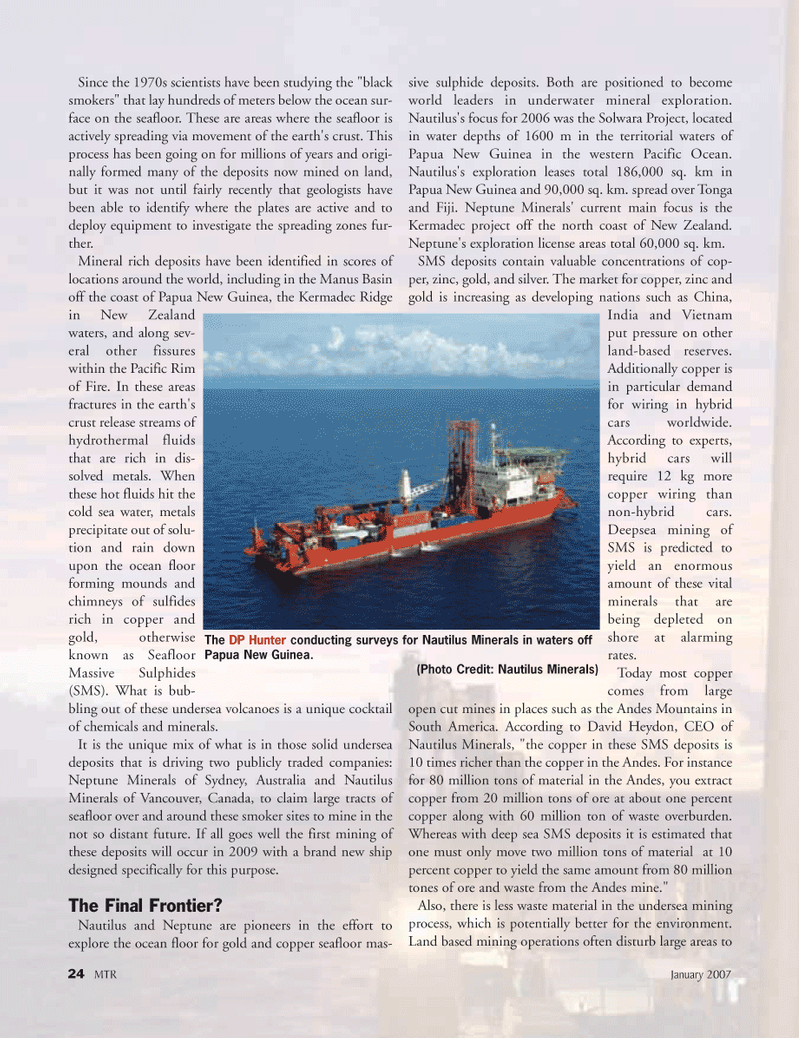
Page 24: of Marine Technology Magazine (January 2007)
Seafloor Engineering
Read this page in Pdf, Flash or Html5 edition of January 2007 Marine Technology Magazine
Since the 1970s scientists have been studying the "black smokers" that lay hundreds of meters below the ocean sur- face on the seafloor. These are areas where the seafloor is actively spreading via movement of the earth's crust. This process has been going on for millions of years and origi- nally formed many of the deposits now mined on land, but it was not until fairly recently that geologists have been able to identify where the plates are active and to deploy equipment to investigate the spreading zones fur- ther.
Mineral rich deposits have been identified in scores of locations around the world, including in the Manus Basin off the coast of Papua New Guinea, the Kermadec Ridge in New Zealand waters, and along sev- eral other fissures within the Pacific Rim of Fire. In these areas fractures in the earth's crust release streams of hydrothermal fluids that are rich in dis- solved metals. When these hot fluids hit the cold sea water, metals precipitate out of solu- tion and rain down upon the ocean floor forming mounds and chimneys of sulfides rich in copper and gold, otherwise known as Seafloor
Massive Sulphides (SMS). What is bub- bling out of these undersea volcanoes is a unique cocktail of chemicals and minerals.
It is the unique mix of what is in those solid undersea deposits that is driving two publicly traded companies:
Neptune Minerals of Sydney, Australia and Nautilus
Minerals of Vancouver, Canada, to claim large tracts of seafloor over and around these smoker sites to mine in the not so distant future. If all goes well the first mining of these deposits will occur in 2009 with a brand new ship designed specifically for this purpose.
The Final Frontier?
Nautilus and Neptune are pioneers in the effort to explore the ocean floor for gold and copper seafloor mas- sive sulphide deposits. Both are positioned to become world leaders in underwater mineral exploration.
Nautilus's focus for 2006 was the Solwara Project, located in water depths of 1600 m in the territorial waters of
Papua New Guinea in the western Pacific Ocean.
Nautilus's exploration leases total 186,000 sq. km in
Papua New Guinea and 90,000 sq. km. spread over Tonga and Fiji. Neptune Minerals' current main focus is the
Kermadec project off the north coast of New Zealand.
Neptune's exploration license areas total 60,000 sq. km.
SMS deposits contain valuable concentrations of cop- per, zinc, gold, and silver. The market for copper, zinc and gold is increasing as developing nations such as China,
India and Vietnam put pressure on other land-based reserves.
Additionally copper is in particular demand for wiring in hybrid cars worldwide.
According to experts, hybrid cars will require 12 kg more copper wiring than non-hybrid cars.
Deepsea mining of
SMS is predicted to yield an enormous amount of these vital minerals that are being depleted on shore at alarming rates.
Today most copper comes from large open cut mines in places such as the Andes Mountains in
South America. According to David Heydon, CEO of
Nautilus Minerals, "the copper in these SMS deposits is 10 times richer than the copper in the Andes. For instance for 80 million tons of material in the Andes, you extract copper from 20 million tons of ore at about one percent copper along with 60 million ton of waste overburden.
Whereas with deep sea SMS deposits it is estimated that one must only move two million tons of material at 10 percent copper to yield the same amount from 80 million tones of ore and waste from the Andes mine."
Also, there is less waste material in the undersea mining process, which is potentially better for the environment.
Land based mining operations often disturb large areas to
The DP Hunter conducting surveys for Nautilus Minerals in waters off
Papua New Guinea. (Photo Credit: Nautilus Minerals) 24 MTR January 2007
MTR#1 (17-32).qxd 1/11/2007 3:55 PM Page 24

 23
23

 25
25
